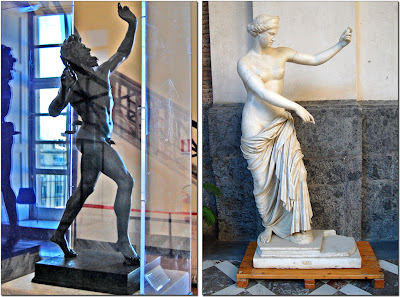 |
The Blue Vase, Museo Archeologico Nazionale di Napoli
Photo by New York Scugnizzo
|
By Giovanni di Napoli
Discovered at Pompeii on December 29, 1837, in the presence of King Ferdinand II, the Blue Vase is regarded by many to be the Naples National Archaeological Museum's most prized possession. Considering the institution's vast collection of antiquities from Pompeii, Herculcneum and Stabiae (not to mention the famed Farnese collection) that's quite a claim.
 |
Close-up of the Blue Vase
Photo by New York Scugnizzo
|
The Blue Vase is said to have been found in the House of the Mosaic Columns during a Royal inspection. Some have suggested it was planted to impress the noble visitors. Apparently, it was not uncommon for excavators to inhume their finds and wait for an opportune time to unearth the treasure in order to keep their patrons excited and the funds coming in.(1)
Extremely fragile, Imperial Roman cameo glass vases are terrifically rare; only a handful survive. Perhaps the most famous specimen is the so-called Portland Vase in the British Museum.
They were made by fusing different colored sheets of glass together in a furnace. After cooling, the top layer was etched away, creating designs that stand out from the contrasting background. As with the Blue Vase, the most common color combination was the use of an opaque white over a translucent cobalt blue.
They were made by fusing different colored sheets of glass together in a furnace. After cooling, the top layer was etched away, creating designs that stand out from the contrasting background. As with the Blue Vase, the most common color combination was the use of an opaque white over a translucent cobalt blue.
Beneath each handle of the Blue Vase the iconography depicts a group of pudgy putti gaily harvesting grapes for winemaking and playing musical instruments. Separating the two scenes are highly elaborate grape vines bearing clusters of fruit and some birds. The vines appear to be springing like antlers from the head of Silenus, the trusty companion of Dionysus, the god of wine. Circling the vessel's base are flora and fauna from the Mediterranean. Fittingly, the glass vessel is shaped like a wine amphora.
Undoubtably the work of master craftsmen, this priceless masterpiece was truly a wonder to behold.
(1) See Robin Brooks, The Portland Vase: The Extraordinary Odyssey of a Mysterious Roman Treasure, Harper Perennial, 2005, p. 221
* * *
Other highlights from the Museo Archeologico Nazionale di Napoli include:
 |
Silverware from the House of Menander
Photo courtesy of Niccolò Graffio
|
 |
The so-called Sapho portrait
Photo by New York Scugnizzo
|
 |
(L-R) Dancing Faun and Aphrodite of Capua
Photos by New York Scugnizzo
|










